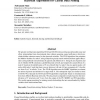Free Online Productivity Tools
i2Speak
i2Symbol
i2OCR
iTex2Img
iWeb2Print
iWeb2Shot
i2Type
iPdf2Split
iPdf2Merge
i2Bopomofo
i2Arabic
i2Style
i2Image
i2PDF
iLatex2Rtf
Sci2ools
JMLR
2010
2010
Bayesian Algorithms for Causal Data Mining
We present two Bayesian algorithms CD-B and CD-H for discovering unconfounded cause and effect relationships from observational data without assuming causal sufficiency which precludes hidden common causes for the observed variables. The CD-B algorithm first estimates the Markov blanket of a node X using a Bayesian greedy search method and then applies Bayesian scoring methods to discriminate the parents and children of X. Using the set of parents and set of children CD-B constructs a global Bayesian network and outputs the causal effects of a node X based on the identification of Y arcs. Recall that if a node X has two parent nodes A,B and a child node C such that there is no arc between A,B and A,B are not parents of C, then the arc from X to C is called a Y arc. The CD-H algorithm uses the MMPC algorithm to estimate the union of parents and children of a target node X. The subsequent steps are similar to those of CD-B. We evaluated the CD-B and CD-H algorithms empirically based on ...
Algorithms | Bayesian Networks | JMLR 2010 | Node |
Related Content
| Added | 19 May 2011 |
| Updated | 19 May 2011 |
| Type | Journal |
| Year | 2010 |
| Where | JMLR |
| Authors | Subramani Mani, Constantin F. Aliferis, Alexander R. Statnikov |
Comments (0)

